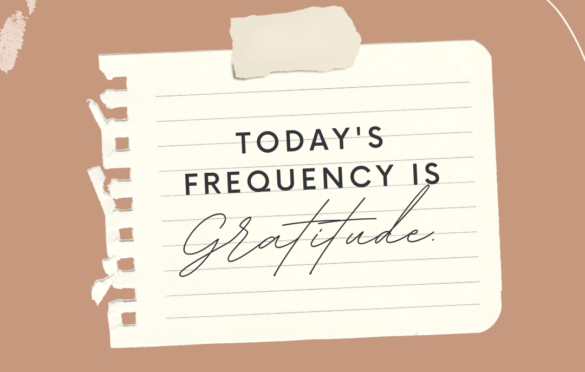Gratitude is the Highest Frequency.

Years ago, I was gifted a CD box-set that detailed the teachings of Esther and Jerry Hicks entitled Ask and It is Given: Learning to Manifest Your Desires. I listened to those CDs repeatedly, and they would help improve my mood each time. A small paper insert was included with the set that illustrated an emotional guidance scale. The creators of the scale ranked emotions in terms of vibrations, with the lowest vibration (#22) being fear and despair and the highest (#1) being appreciation. The concept at the basis of their teaching was both simple and profound – gratitude is the highest frequency.
Gratitude is an expression, feeling, and trait. It is the display of appreciation for what we have and an energy that reverberates from within. When we are grateful, we are less likely to complain and more likely to attract. We are focused on the present moment and not preoccupied with the future or past. Gratitude requires us to stop and feel thankful, a vibration that cannot be surpassed.
But how do you reach gratitude if you’re at a low vibrational state? A question I often asked when first listening to those CDs. The authors suggested that it wasn’t feasible to instantly move from the lowest vibrational state to the highest one. Instead, you had to work your way up the scale. If you were stuck in guilt and unworthiness (#21), you’d give yourself grace to journey up the next twenty steps. There wasn’t a magic potion or easy fix, just dedication to training your brain to be grateful.
Ask and It Is Given was written nearly twenty years ago, and since then, researchers have studied gratitude a lot. A 2017 study suggests gratitude changes our brain, rewiring our prefrontal cortex and improving our mental health over time. And there is a great deal of evidence that suggests gratitude can improve our physical health also by protecting against heart disease. There’s no wrong time to be grateful, and the benefits associated with its practice are seemingly unending. So how can we express greater gratitude? Ask, and it is given.
Meditation and prayer are age-old practices that can instantly improve our state of consciousness. By connecting with ourselves and Higher Power, we can be transported to a place of thankfulness anywhere and at any time. Another way to cultivate gratitude is to continuously count our blessings, whether mentally or by keeping a list. Setting aside time to reflect on everything God has brought us to and through can help to adjust our spirit and perspective. If you’re looking for a more tangible way to give thanks, try creating thank you cards or using a gratitude journal; these physical practices can be used repeatedly if needed. You can also try phoning a friend or family member to show appreciation to the supportive people in your life.
There’s always something to be thankful for in our lives; we just have to be willing to see it. Through practicing gratitude continuously, we can create more to appreciate. Thank you for reading Hugs for Black Women. We are grateful to share our online community with you. Read more about the science behind gratitude here and share your tips for remaining thankful with us below.






Racheal
Good one!! Thankfulness, cause I don’t need not a nan heart disease. In all seriousness, there’s a lot to be thankful for and my have we been reminded during these last few years!
Guyla J
Ahhh, good read. I find that when i do reflect I can fully appreciate what’s going on around me. I become grateful and fulfilled. #gratitude